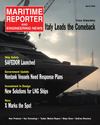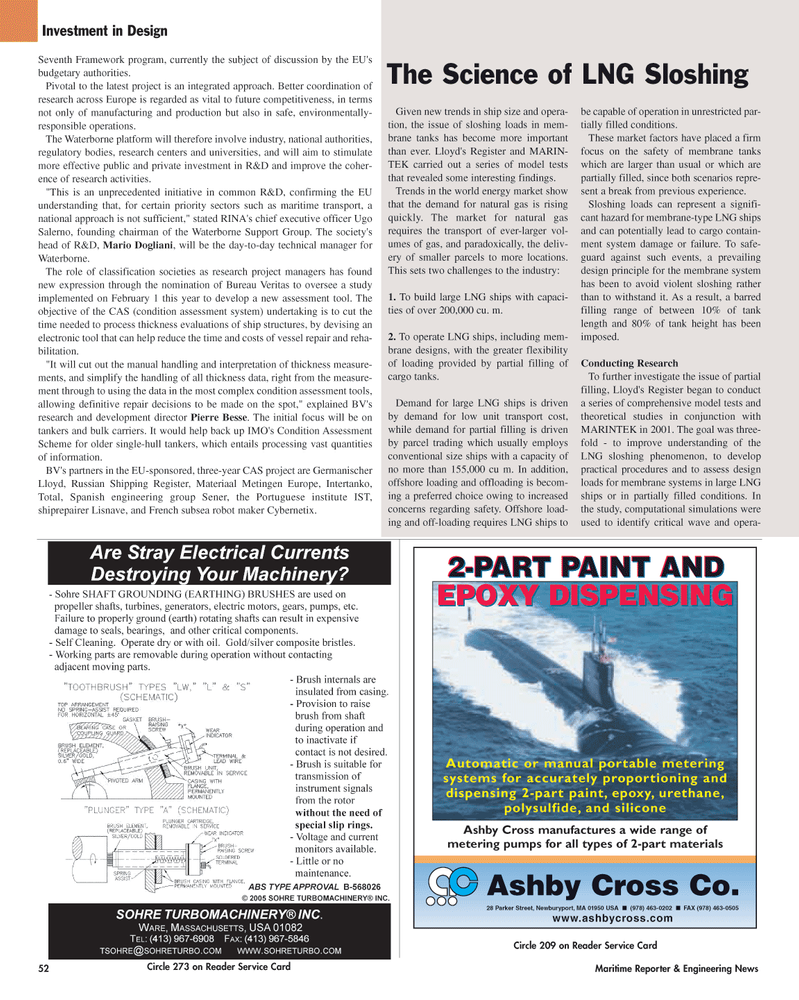
Page 52: of Maritime Reporter Magazine (March 2, 2005)
Read this page in Pdf, Flash or Html5 edition of March 2, 2005 Maritime Reporter Magazine
52 Maritime Reporter & Engineering News
Seventh Framework program, currently the subject of discussion by the EU's budgetary authorities.
Pivotal to the latest project is an integrated approach. Better coordination of research across Europe is regarded as vital to future competitiveness, in terms not only of manufacturing and production but also in safe, environmentally- responsible operations.
The Waterborne platform will therefore involve industry, national authorities, regulatory bodies, research centers and universities, and will aim to stimulate more effective public and private investment in R&D and improve the coher- ence of research activities. "This is an unprecedented initiative in common R&D, confirming the EU understanding that, for certain priority sectors such as maritime transport, a national approach is not sufficient," stated RINA's chief executive officer Ugo
Salerno, founding chairman of the Waterborne Support Group. The society's head of R&D, Mario Dogliani, will be the day-to-day technical manager for
Waterborne.
The role of classification societies as research project managers has found new expression through the nomination of Bureau Veritas to oversee a study implemented on February 1 this year to develop a new assessment tool. The objective of the CAS (condition assessment system) undertaking is to cut the time needed to process thickness evaluations of ship structures, by devising an electronic tool that can help reduce the time and costs of vessel repair and reha- bilitation. "It will cut out the manual handling and interpretation of thickness measure- ments, and simplify the handling of all thickness data, right from the measure- ment through to using the data in the most complex condition assessment tools, allowing definitive repair decisions to be made on the spot," explained BV's research and development director Pierre Besse. The initial focus will be on tankers and bulk carriers. It would help back up IMO's Condition Assessment
Scheme for older single-hull tankers, which entails processing vast quantities of information.
BV's partners in the EU-sponsored, three-year CAS project are Germanischer
Lloyd, Russian Shipping Register, Materiaal Metingen Europe, Intertanko,
Total, Spanish engineering group Sener, the Portuguese institute IST, shiprepairer Lisnave, and French subsea robot maker Cybernetix.
Circle 273 on Reader Service Card
Circle 209 on Reader Service Card 2-PART PAINT AND
EPOXY DISPENSING
Ashby Cross Co. 28 Parker Street, Newburyport, MA 01950 USA ¦ (978) 463-0202 ¦ FAX (978) 463-0505 www.ashbycross.com
Automatic or manual portable metering systems for accurately proportioning and dispensing 2-part paint, epoxy, urethane, polysulfide, and silicone
Ashby Cross manufactures a wide range of metering pumps for all types of 2-part materials
Investment in Design
Given new trends in ship size and opera- tion, the issue of sloshing loads in mem- brane tanks has become more important than ever. Lloyd's Register and MARIN-
TEK carried out a series of model tests that revealed some interesting findings.
Trends in the world energy market show that the demand for natural gas is rising quickly. The market for natural gas requires the transport of ever-larger vol- umes of gas, and paradoxically, the deliv- ery of smaller parcels to more locations.
This sets two challenges to the industry: 1. To build large LNG ships with capaci- ties of over 200,000 cu. m. 2. To operate LNG ships, including mem- brane designs, with the greater flexibility of loading provided by partial filling of cargo tanks.
Demand for large LNG ships is driven by demand for low unit transport cost, while demand for partial filling is driven by parcel trading which usually employs conventional size ships with a capacity of no more than 155,000 cu m. In addition, offshore loading and offloading is becom- ing a preferred choice owing to increased concerns regarding safety. Offshore load- ing and off-loading requires LNG ships to be capable of operation in unrestricted par- tially filled conditions.
These market factors have placed a firm focus on the safety of membrane tanks which are larger than usual or which are partially filled, since both scenarios repre- sent a break from previous experience.
Sloshing loads can represent a signifi- cant hazard for membrane-type LNG ships and can potentially lead to cargo contain- ment system damage or failure. To safe- guard against such events, a prevailing design principle for the membrane system has been to avoid violent sloshing rather than to withstand it. As a result, a barred filling range of between 10% of tank length and 80% of tank height has been imposed.
Conducting Research
To further investigate the issue of partial filling, Lloyd's Register began to conduct a series of comprehensive model tests and theoretical studies in conjunction with
MARINTEK in 2001. The goal was three- fold - to improve understanding of the
LNG sloshing phenomenon, to develop practical procedures and to assess design loads for membrane systems in large LNG ships or in partially filled conditions. In the study, computational simulations were used to identify critical wave and opera-
The Science of LNG Sloshing
MR MARCH 2005 #7 (49-56).qxd 3/1/2005 5:19 PM Page 4

 51
51

 53
53
